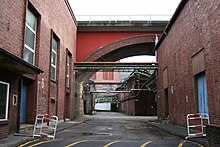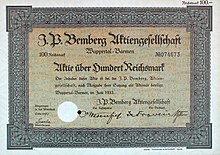JP Bemberg
The JP Bemberg AG was a traditional German textile company formed by the merger with 1971 Glanzstoffwerke AG in the Enka AG rose.
history
1792 Kaufmann founded Johann Peter Bemberg in Elberfeld (now part of Wuppertal ) a wine shop, which is on trade in dyes , cotton and wool to a Turkish red - dyeing developed.
The husband of his granddaughter Therese, Friedrich A. Platzhoff , relocated the company to the Öhde in 1865 and expanded by founding or taking over factories in Barmen (now also part of Wuppertal), Krefeld and Augsburg , among other things mechanical artificial silk weaving mills , which from the 1896 acquired Max Triepke weaving mill . In 1903 the transformation took place into a public limited company under the company J. P. Bemberg AG .
In 1900 Emil Thiele began attempts to develop the draw spinning process for copper silk (DRP nos. 154 507 and 157 157), which led to the start of copper rayon production in 1904 and, from 1909, the draw spinning process that was now ready for production. In the years that followed, only copper rayon was produced, and dyeing was finally given up in 1918. At the beginning of the 1930s, JP Bemberg began manufacturing the Bemberg cell glass "Cuprophan". International branches , including in Italy , Bemberg SpA, Milan, France , Japan , the United Kingdom and the United States , Beaunit Mills Inc., New York, followed.
In 1925, the majority of the shares in Vereinigte Glanzstoff-Fabriken AG , which had been working with Bemberg through contractual agreements, were taken over. The gloss material was in the next time, the copper process to completely - apart from the production of copper-Sirius (a monofilament yarn in strong titers, so-called artificial horsehair) which was maintained for some time. In the same year, Glanzstoff and JP Bemberg founded the American Bemberg Corporation with headquarters in New York City and a plant in Johnson City ( Tennessee ). Both companies also took part in the establishment of Seta Bemberg SpA in Gozzano (Italy). Since 1927, the company has focused on artificial silk production. In 1929, the Nippon Bemberg Kenshi Kabushiki Kaisha , based in Osaka, was founded together with the Glanzstoff and the Asahi Kenshoku Kabushiki Kaisha . The two Japanese companies became Asahi-Bemberg-Rayon-Co in 1933 . united. In 1940 JP Bemberg applied for a patent for the "Dureta" process for the continuous production of rayon using the copper process (DRP No. 763735). During the Second World War, the production of parachute silk predominated (up to 40 tons of silk a day with 4,400 employees).
On March 13, 1945, 70% of the production facilities were destroyed in an air raid. With the end of the war, the foreign branches were lost. In 1946 the company was re-established with around 300 employees. The production flourished with Perlon , 1962, selling but of glossy material and chemical copper silk Bemberg®, Cuprophan , Bemberg- Lavabel and tissues of mechanical art silk weaving in Augsburg under his own name. In 1963, 3,083 employees achieved a turnover of 100,976,000 DM. The capital at that time was 45 million DM. VGF owned 80.8%, AKU 8.7% and free shareholders 10.5%. By 1969 around 3,800 people were employed again. In 1971 Bemberg merged with Glanzstoff AG , the new company traded under the name Enka Glanzstoff AG .
Environmental damage
From the artificial silk production in Gozzano in northern Italy , copper and ammonium sulphate have found their way into Lake Orta since 1927 . After two years there was no fish in the lake and for decades it was considered biologically dead. The first use of copper filters began in 1956, and sewage discharges ended thirty years later. Together with accompanying environmental measures , the biological life in the lake has been regenerating since the 1990s.
See also
literature
- Robert Bauer: Chemical fiber lexicon. Series of publications of the textile economy. 5th edition, 1965. Deutscher Fachverlag GmbH, Frankfurt am Main.
Web links
- Early documents and newspaper articles on JP Bemberg in the 20th century press kit of the ZBW - Leibniz Information Center for Economics .
Individual evidence
- ^ Carla Bonacina: Lake Orta: the undermining of an ecosystem. In: J. Limnol. 60 (1): 53-59, 2001, p. 53.

